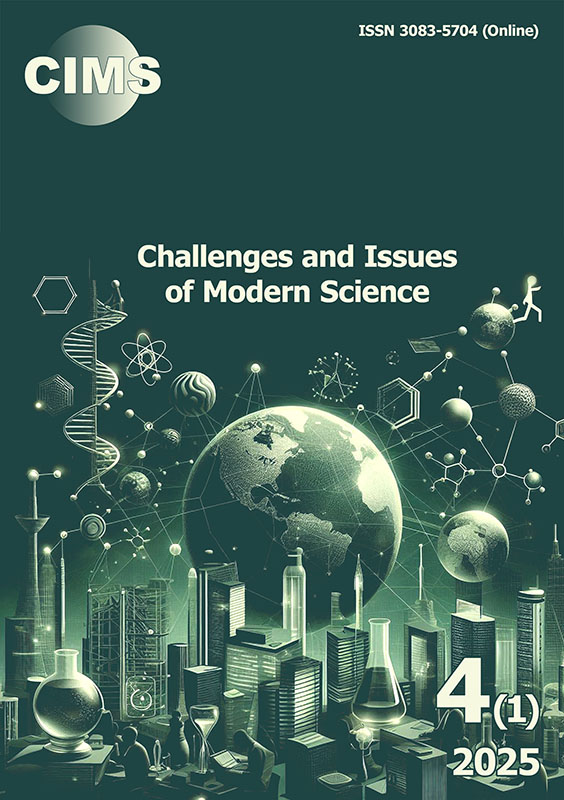Open-source analysis of the potential configuration and kinetic performance of the Oreshnik ballistic missile
DOI:
https://doi.org/10.15421/cims.4.306Keywords:
Oreshnik system, kinetic warhead, suborbital trajectory, aerodynamic heating, propulsion configuration, ballistic missileAbstract
Purpose. This article presents an analysis of the tactical and technical characteristics of the Oreshnik medium-range ballistic missile, which, according to open-source data, was employed in a precision strike against an infrastructure facility in Dnipro in November 2024. The study focuses on the missile’s configuration, warhead type, and aerodynamic behavior using open-source information. Design / Method / Approach. An interdisciplinary methodology was applied, comprising Sentinel-2 satellite imagery analysis, kinetic-energy and aerodynamic-heating modeling, and comparative assessment against the Russian Avangard, Rubezh, and UR-100N UTTKh platforms. Missile debris and factory markings were used to reconstruct manufacturing chronology and identify design features. Findings. It was determined that Oreshnik is equipped with a hypersonic non-explosive kinetic warhead capable of destructive impact via high-velocity collision. The missile likely follows a suborbital trajectory, achieving speeds of 11–12 km/s and surface temperatures in excess of 4300 K. Markings indicate key components were manufactured in 2017, suggesting reuse of legacy platforms. Theoretical Implications. This work advances the theory of kinetic-impact systems by elucidating thermal-loading mechanisms and energy-transfer processes in hypersonic vehicles, thereby bridging contemporary implementations with the historical “Rods from God” concept. Practical Implications. The findings reveal limited strike effectiveness owing to high costs and moderate destructive yield, yet underscore the system’s value as a demonstrator technology and its utility for hypersonic-system testing. Originality / Value. This study constitutes the first technical analysis of an Oreshnik missile strike based exclusively on open-source data, illustrating the growing role of civilian satellite imagery and interdisciplinary modeling in arms-monitoring. Research Limitations / Future Research. The analysis relies solely on open-source information. Future work should include detailed damage assessment, thermal-protection analysis, and expanded trajectory modeling with advanced software tools. Enhanced monitoring of high-velocity conventional weapons is recommended to support arms-control and humanitarian-law frameworks. Article Type. Applied research.
Downloads
References
Bartles, C. K. (2017). Russian threat perception and the ballistic missile defense system. The Journal of Slavic Military Studies, 30(2), 152-169. https://doi.org/10.1080/13518046.2017.1307016
Bin, Y. (2024). Moscow and Beijing at the Dawn of A Grave New World of Trump 2.0. Comparative Connections: A Triannual E-Journal on East Asian Bilateral Relations, 26(2). https://cc.pacforum.org/2024/12/moscow-and-beijing-at-the-dawn-of-a-grave-new-world-of-trump-2-0
Bondarenko, M., & Gabrinets, V. (2023). Thrust vector control of solid rocket motors for tactical missiles. Journal of Rocket-Space Technology, 31(4), 26-31. https://doi.org/10.15421/452304
Bondarenko, M., & Vorobei, M. (2024). Modern air defense methods and countermeasures for use in operational-tactical missiles. Challenges and Issues of Modern Science, 2, 175-183. https://cims.fti.dp.ua/j/article/view/188
Bondarenko, M., Habrinets, V., & Vorobei, M. (2024). Evolution of Multiple Launch Rocket Systems from Early Rockets to HIMARS and Beyond. Challenges and Issues of Modern Science, 3, 23-34. https://cims.fti.dp.ua/j/article/view/241
Gady, F.-S. (2019). Report: Russia to Produce 60 Avangard Hypersonic Boost-Glide Warheads. Diplomat Media Inc. https://thediplomat.com/2019/07/report-russia-to-produce-60-avangard-hypersonic-boost-glide-warheads
Graef, A. (2024). US-Mittelstreckenwaffen in Deutschland: Abschreckung und Rüstungskontrolle zusammen denken. Institut für Friedensforschung und Sicherheitspolitik. https://doi.org/10.25592/ifsh-policy-brief-0424
Gubrud, M. A. (2011). Chinese and US kinetic energy space weapons and arms control. Asian Perspective, 35(4), 617-641. http://doi.org/10.1353/apr.2011.0026
Hitchens, T., Katz-Hyman, M., & Lewis, J. (2006). US space weapons: big intentions, little focus. Nonproliferation Review, 13(1), 35-56. https://doi.org/10.1080/10736700600861350
Kadyshev, T., & Kütt, M. (2024). Analyzing the Utility of Arrow 3 for European Missile Defense Using Footprint Calculations. Science & Global Security, 32(1-3), 174-218. https://doi.org/10.1080/08929882.2024.2444750
Kalvinkar, M., Jacob, K., & Reddy, P. (2024). Hypersonic High Speed Strike Weapons: Design, Research and Development. Acceleron Aerospace Journal, 3(5), 593-599. https://doi.org/10.61359/11.2106-2461
Khanolkar, N. P., Bhushan, B., Siddharth, M., Borrison, E., & Sinha, J. (2017, December). Analysis of aerodynamic characteristics of a missile configuration. In 2017 International Conference on Infocom Technologies and Unmanned Systems (Trends and Future Directions) (ICTUS) (pp. 877-882). IEEE. http://doi.org/10.1109/ICTUS.2017.8286129
Kristensen, H. M., Korda, M., & Reynolds, E. (2023). Russian nuclear weapons, 2023. Bulletin of the Atomic Scientists, 79(3), 174-199. https://doi.org/10.1080/00963402.2023.2202542
Lee, K. K. (2024). A Study on the Change Trends and Implications of North Korea-Russia Relations: Focusing on the Comprehensive Strategic Partnership Agreement. Convergence Security Journal, 24(3), 209-218. https://doi.org/10.33778/kcsa.2024.24.3.209
Lees, L. (1965). Kinetic theory description of rarefied gas flow. Journal of the Society for Industrial and Applied Mathematics, 13(1), 278-311. https://doi.org/10.1137/0113017
Malinowski, P. (2020). Hypersonic weapon as a new challenge for the anti-aircraft defense command and control system. Safety & Defense, 6(2), 89-99. https://doi.org/10.37105/sd.87
Maloney, S. M. (2015). Remembering Soviet Nuclear Risks. Survival, 57(4), 77-104. https://doi.org/10.1080/00396338.2015.1068558
Meng, Y. S., Yan, L., Huang, W., & Tong, X. Y. (2020, July). Numerical investigation of the aerodynamic characteristics of a missile. In IOP Conference Series: Materials Science and Engineering (Vol. 887, No. 1, p. 012001). IOP Publishing. https://doi.org/10.1088/1757-899X/887/1/012001
Moric, I., & Kadyshev, T. (2025). Forecasting Costs of US Ballistic Missile Defense Against a Major Nuclear Strike. Defence and Peace Economics, 36(2), 141-166. https://doi.org/10.1080/10242694.2024.2396415
Schneider, M. B. (2024). How many nuclear weapons does Russia have? The size and characteristics of the Russian nuclear stockpile. Comparative Strategy, 43(4), 305-433. https://doi.org/10.1080/01495933.2024.2363738
Senglaub, M. (1996). Systems engineering analysis of kinetic energy weapon concepts (No. SAND-96-1413). Sandia National Lab.(SNL-NM), Albuquerque, NM (United States). https://doi.org/10.2172/273723
Seo, H. (2024). In the Shadow of the Cold War: Structural Analysis on US-Russia Relations. The Korean Journal of International Studies, 22(3), 271-310. https://doi.org/10.14731/kjis.2024.12.22.3.271
Singh, U. K., Padmanabhan, V., & Agarwal, A. (2013, August). A novel method for training and classification of ballistic and quasi-ballistic missiles in real-time. In The 2013 International Joint Conference on Neural Networks (IJCNN) (pp. 1-8). IEEE. http://doi.org/10.1109/IJCNN.2013.6707115
Smetana, M., & Onderco, M. (2025). “Hope the Russians Love Their Children Too”: Russian Public Support for the Use of Nuclear Weapons after the Invasion of Ukraine. Journal of Global Security Studies, 10(3), ogaf012. https://doi.org/10.1093/jogss/ogaf012
Swaminathan, P. K., Taylor, J. C., Rault, D. F., Erlandson, R. E., & Meng, C. I. (1996). Transition regime aerodynamic heating of missiles. Journal of spacecraft and rockets, 33(5), 607-613. https://doi.org/10.2514/3.26809
Tanevski, S. (2025). French diplomacy and the war in Ukraine. Knowledge - International Journal, 69(1), 335–340. https://ojs.ikm.mk/index.php/kij/article/view/7243
Usman, K. (2025). Ukraine from offensive to defensive. Available at SSRN 5150489. https://doi.org/10.2139/ssrn.5150489
Won, Y. (2025). Why is North Korea helping Russia's war on Ukraine? Green Left, 1422, https://www.greenleft.org.au/content/why-north-korea-helping-russias-war-ukraine
Zhouwei, Z., Yaosen, L., Wang, Y., & Fan, X. (2022, September). Development overview of Russian ballistic missile and missile defense system. In International Conference on Mechanical Design and Simulation (MDS 2022) (Vol. 12261, pp. 252-263). SPIE. https://doi.org/10.1117/12.2638612
Zhu, M., Zhang, H., Feng, L., & Lu, X. (2024, February). Assessment and Research of Destructive Effects of the Space-based Weapon. In 2024 International Conference on Electrical Drives, Power Electronics & Engineering (EDPEE) (pp. 397-403). IEEE. http://doi.org/10.1109/EDPEE61724.2024.00081
Downloads
Published
Versions
- 2025-06-24 (2)
- 2025-06-01 (1)
Issue
Section
Categories
License
Copyright (c) 2025 Mykola Bondarenko, Volodymyr Habrinets, Mykhailo Vorobei (Author)

This work is licensed under a Creative Commons Attribution 4.0 International License.
All articles published in the journal Challenges and Issues of Modern Science are licensed under the Creative Commons Attribution 4.0 International (CC BY) license. This means that you are free to:
- Share, copy, and redistribute the article in any medium or format
- Adapt, remix, transform, and build upon the article
as long as you provide appropriate credit to the original work, include the authors' names, article title, journal name, and indicate that the work is licensed under CC BY. Any use of the material should not imply endorsement by the authors or the journal.



















